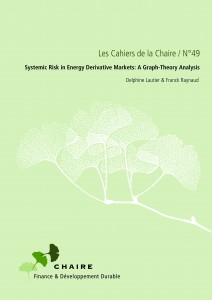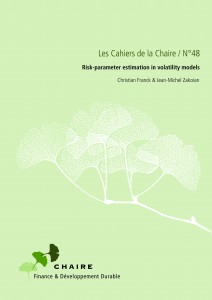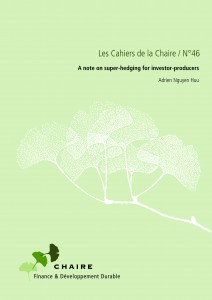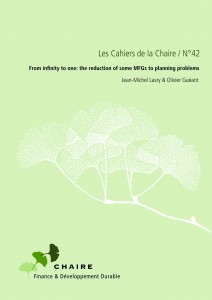This article uses graph theory to provide novel evidence regarding market integration, a favorable condition for systemic risk tio appear in. Relying on daily futures returns covering a 12-year period, we examine cross- and inter-market linkages, both within the commodity complex and between commodities and other financial assets. In such a high dimensional analysis, the graph theory enables us to understand the dynamic behavior of our price system. We also establish that crude oil is itself at the center of the energy complex. Further, we provide evidence that commodity markets are becoming more integrated over time.
Systemic Risk in Energy Derivative Markets: A Graph-Theory Analysis
Risk-Parameter Estimation in Volatility Models
.
by Christian Franck & Jean-Michel Zakoïan
Ecological intuition versus Economic “reason”
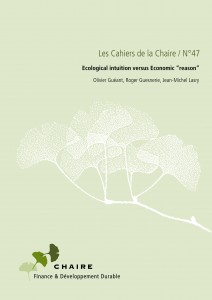 by Olivier Guéant, Roger Guesnerie & Jean-Michel Lasry
by Olivier Guéant, Roger Guesnerie & Jean-Michel Lasry
This article discusses the discount rate to be used in projects that aimed at preserving the environment. The model has two di§erent goods, one is the usual consumption good whose production may increase exponentially, the other is an environmental good whose quality remains limited. The stylized world we describe is fully determined by four parameters reáecting basic preferences, “ecological” and intergenerational concerns and feasibility constraints. We define an ecological discount rate and examine its connections with the usual interest rate and the optimized growth rate. We discuss, in this simple world, di§erent forms of the precautionary principle and show that cost-beneÖt analysis should overweigh in a spectacular way the probabilities of the events associated with bad environmental outcomes.
A note on super-hedging for investor-producers
We study the situation of an investor-producer who can trade on a financial market in continuous time and can transform some assets into others by means of a discrete time production system, in order to price and hedge derivatives on produced goods. This general framework covers the interesting case of an electricity producer who wants to hedge a financial position and can trade commodities which are also inputs for his system. This extends the framework of (Bouchard and Nguyen, 2011) to continuous time for concave and bounded production functions. We introduce the flexible concept of conditional sure profit along the idea of the no sure profit condition of (Rasonyi, 2009) and show that it allows one to provide a closedness property for the set of super-hedgeable claims in a very general setting. Using standard separation arguments, we then deduce a dual characterization of the latter.
Journée de la Chaire FDD et du Laboratoire FIME
6 décembre 2011 – EDF R&D – site de Clamart
Cette journée consacrée à la présentation des travaux de recherche réalisés dans le cadre de la Chaire Finance et Développement Durable et du Laboratoire de Finance des Marchés de l’Energie a été organisée cette année dans les locaux de EDF R&D (site de Clamart). Une partie de la journée étaité consacrée à la présentation du bilan des 5 premières années de la Chaire et du Laboratoire.
supports des présentations des différentes sessions sur le site du laboratoire FIME
Natural and Industrial Disasters: Land Use and Insurance
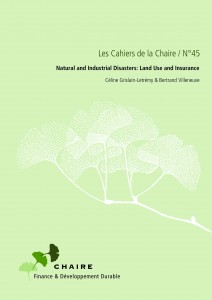 by Céline Grislain-Letrémy & Bertrand Villeneuve
by Céline Grislain-Letrémy & Bertrand Villeneuve
Uncontrolled urbanization in exposed areas increases the cost of natural and industrial disas- ters. In the case of industrial risks, these land use externalities are directly exerted on the firm which is liable for the disaster. In the case of natural risks, the externalities take the form of free- riding on the mutualization mechanism. Land use policy and insurance can provide incentives to internalize these externalities. However these tools cannot be more precise than the hazard map on which they are based. We describe the efficiency gains of refining hazard categories, keeping in mind that they should be balanced with assessment costs. We determine the impact of climate change and demographic evolution on the equilibrium. Our results are established for a spectrum of alternative scenarios with various distributions of bargaining power between the households, the mayor and the firm.
Trading & Micro structure “Focus on High Frequency Market Making”
 September 9th 2011, 9h30 – 12h30
September 9th 2011, 9h30 – 12h30
Collège de France – 3 rue d’Ulm – 75005 PARIS
The goal of the workshop is to be a forum for confronting viewpoints between practicioners and academics on topics related to developments in the area of market microstructure (limit order books, high frequency trading, optimal trading strategies, market design, competition between trading venues etc…). This is the 3rd edition of the worskhop.
Optimal Portfolio Liquidation with Limit Orders
 by Olivier Guéant, Charles-Albert Lehalle & Joaquin Fernandez Tapia
by Olivier Guéant, Charles-Albert Lehalle & Joaquin Fernandez Tapia
This paper addresses the optimal scheduling of the liquidation of a portfolio using a new angle. Instead of focusing only on the scheduling aspect like Almgren and Chriss in [2], or only on the liquidity-consuming orders like Obizhaeva and Wang in [31], we link the optimal trade-schedule to the price of the limit orders that have to be sent to the limit order book to optimally liquidate a portfolio. Most practitioners address these two issues separately: they compute an optimal trading curve and they then send orders to the markets to try to follow it. The results obtained here solve simultaneously the two problems. As in a previous paper that solved the “intra-day market making problem” [19], the interactions of limit orders with the market are modeled via a Poisson process pegged to a diffusive “fair price” and a Hamilton-Jacobi-Bellman equation is used to solve the trade-off between execution risk and price risk. Backtests are finally carried out to exemplify the use of our results.
Dealing with the Inventory Risk
 by Olivier Guéant, Charles-Albert Lehalle & Joaquin Fernandez Tapia
by Olivier Guéant, Charles-Albert Lehalle & Joaquin Fernandez Tapia
Market makers have to continuously set bid and ask quotes for the stocks they have under consideration. Hence they face a complex optimization problem in which their return, based on the bid-ask spread they quote and the frequency they indeed provide liquidity, is chal- lenged by the price risk they bear due to their inventory. In this paper, we provide optimal bid and ask quotes and closed-form approximations are derived using spectral arguments.
From infinity to one: the reduction of some MFGs to planning problems
This paper presents recent results from Mean Field Game theory underlying the intro- duction of common noise that imposes to incorporate the distribution of the agents as a state variable. Starting from the usual mean field games equations introduced in [11, 12, 13] and adapting them to games on graphs, we introduce a partial differential equation, often referred to as the Master equation (see [14]), from which the MFG equations can be deduced. Then, this Master equation can be reinterpreted using a global control problem inducing the same behaviors as in the non-cooperative initial mean field game.
Stochastic Target Problems with Controlled Loss in Jump Diffusion Models
 By Ludovic Moreau Stochastic Target Problems with Controlled Loss in Jump Diffusion Models
By Ludovic Moreau Stochastic Target Problems with Controlled Loss in Jump Diffusion Models
In this paper, we consider a mixed diffusion version of the stochastic target problem introduced in [3]. This consists in finding the minimum initial value of a controlled process which guarantees to reach a controlled stochastic target with a given level of expected loss. As in [3], it can be converted into a standard stochastic target problem, as already studied in [10], [9] or [2] for the mixed diffusion case, by increasing both the state space and the dimension of the control. In our mixed-diffusion setting, the main difficulty comes from the presence of jumps, which leads to the introduction of a new kind of controls that take values in an unbounded set of measurable maps. This has non trivial technical impacts on the formulation and derivation of the associated partial differential equations.
Key words: Stochastic target problem, mixed diffusion process, discontinuous viscosity solu- tions, quantile hedging.
Taux d’actualisation, modèles comptables et développement durable
May 23, 24 and 25 2011 – Université Paris-Dauphine
1ère séance (23/05), 18h00 – 19h30, salle A707:
Conservation du capital : modèles comptables vs modèles financiers2ème séance (24/05), 18h00 – 19h30, salle A707:
Actualisation et théorie économique : environmental economics vs ecological economics3ème séance (25/05), 18h00 – 19h30, salle A707:
La comptabilité environnementale : une solution au problème de l’actualisation ?
Fundamentals, Speculation and Commodity Markets
May 30th 2011, from 9:00am to 17:15 pm – Université Paris-Dauphine, A709
Michel A. Robe – Associate Professor of Finance, American University: Pr. Robe teaches derivatives and international finance at American University’s (AU) Kogod School of Business in Washington, DC. Before joining AU, he taught international finance and investments at the University of Miami in Florida, and at McGill University in Montréal, Canada. Since being tenured in 2004, he has advised national regulators on investor protection, financial contagion, and commodity markets. He has also served as an expert witness in numerous legal enforcement cases. His research on asset pricing, insider trading, financial regulation, security design, volatility, cross-market financial flows and risk sharing has appeared in leading publications such as the Journal of Financial Economics, Journal of Financial and Quantitative Analysis, International Economic Review, Journal of Futures Markets, in other academic journals and in books. His current work includes research on the limits to arbitrage and market efficiency, the organization and evolution futures markets, commodity speculation, and the role of different types of traders in energy and other derivative markets. Prof. Robe received his Ph.D. in Financial Economics from Carnegie Mellon University.
On a mean field game approach modeling congestion and aversion in pedestrian crowds
 By Aimé Lachapelle & Marie-Therese Wolfram (Cahier de la Chaire n°40)
By Aimé Lachapelle & Marie-Therese Wolfram (Cahier de la Chaire n°40)
In this paper we present a new class of pedestrian crowd models based on the mean field games theory introduced by Lasry and Lions in 2006. This macroscopic approach is based on a microscopic model, that considers smart pedestrians who rationally interact and anticipate the future. This leads to a forward-backward structure in time. We focus on two-population interactions and validate the modeling with simple examples such as self-organization behavior as for instance lane formation. Two complementary classes of problems are addressed, namely the case of crowd aversion and the one of congestion. In both cases we describe the model, build a numerical solver (respectively based on optimization formulation and partial differential equations), and finally provide some numerical tests involving complex group behaviors such as symmetry breaking and lane formation.
Keywords: Mean field games, interacting populations, Nash equilibrium, rational expectations, flow of pedestrians, lane formation, numerical approximation
A class of DCC asymmetric GARCH models driven by exogenous variables
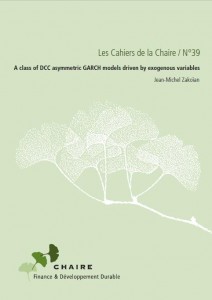 By Jean-Michel Zakoïan (Cahier de la Chaire n°39)
By Jean-Michel Zakoïan (Cahier de la Chaire n°39)
This paper considers Dynamic Conditional Correlations (DCC) GARCH models in which the time-varying coefficients, including the conditional correlation matrix, are functions of the realizations of an exogenous stochastic process. Time series generated by this model are in general nonstationary. Necessary and sufficient conditions are given for the existence of non-explosive solutions, and for the existence of second-order moments of these solutions. Potential applications concern the modeling of the volatility of a vector of energy prices, the model coefficients depending on the weather conditions.
Keywords: Dynamic conditional correlation, Existence of nonexplosive solutions, Multivariate GARCH, Nonstationary processes, Time-varying models
A structural risk-neutral model for pricing and hedging power derivatives
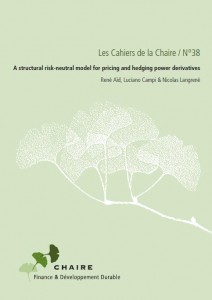 By René Aïd, Luciano Campi & Nicolas Langrené (Cahier de la Chaire n°38)
By René Aïd, Luciano Campi & Nicolas Langrené (Cahier de la Chaire n°38)
We develop a structural risk-neutral model for energy market modifying along several directions the approach introduced in [Aïd et al., 2009]. In particular a scarcity function is introduced to allow important deviations of the spot price from the marginal fuel price, producing price spikes. We focus on pricing and hedging electricity derivatives. The hedging instruments are forward contracts on fuels and electricity. The presence of production capacities and electricity demand makes such a market incomplete. We follow a local risk minimization approach to price and hedge energy derivatives. Despite the richness of information included in the spot model, we obtain closed-form formulae for futures prices and semi-explicit formulae for spread options and European options on electricity forward contracts. An analysis of the electricity price risk premium is provided showing the contribution of demand and capacity to the futures prices. We show that when far from delivery, electricity futures behave like a basket of futures on fuels.
Keywords: Electricity spot and forward prices, fuels, capacity, electricity demand, scarcity function, local risk minimization, minimal martingale measure, power derivatives, spread options, extended incomplete Goodwin-Staton integral
Statistical properties of derivatives: a journey in term structures
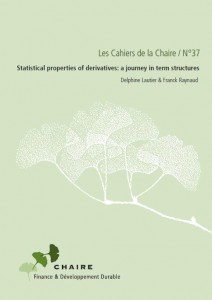 By Delphine Lautier & Franck Raynaud (Cahier de la Chaire n°37)
By Delphine Lautier & Franck Raynaud (Cahier de la Chaire n°37)
This article presents an empirical study of thirteen derivative markets for commodity and financial assets. This paper goes beyond statistical analysis by including the maturity as a variable for futures contracts’s daily returns, from 1998 to 2010 and for delivery dates up to 120 months. We observe that the mean and variance of the commodities follow a scaling behavior in the maturity dimension with an exponent characteristic of the Samuelson effect. The comparison of the tails of the probability distribution according to the expiration dates shows that there is a segmentation in the fat tails exponent term structure above the Lévy stable region. Finally, we compute the average tail exponent for each maturity and we observe two regimes of extreme events for derivative markets, reminding of a phase diagram with a sharp transition at the 18th delivery month.
Keywords: Econophysics, Derivatives, Term structures, Tail exponents, PACS:
Detecting the Maximum of a Mean-Reverting Scalar Diffusion
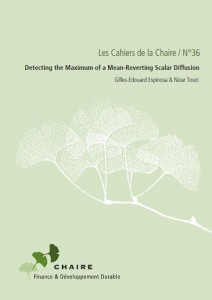 By Gilles-Edouard Espinosa & Nizar Touzi (Cahier de la Chaire n°36)
By Gilles-Edouard Espinosa & Nizar Touzi (Cahier de la Chaire n°36)
Let X be a mean reverting scalar process, X the corresponding running maximum, T0 the first time X hits the level zero and ` a loss function, mainly increasing and convex. We consider the following optimal stopping problem (…) over all stopping times with values in [0; T0]. Under mild conditions, we prove that an optimal stopping time exists and is defined by (…) where the boundary is explicitly characterized as the concatenation of the solutions of two equations. We investigate some examples such as the Ornstein-Uhlenbeck process, the CIR-Feller process, as well as the standard and drifted Brownian motions. Finally, we perform an empirical examination of the efficiency of this strategy on real financial data.
Large liquidity expansion of super-hedging costs
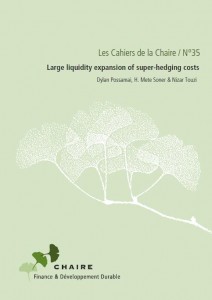 By Dylan Possamai, H. Mete Soner & Nizar Touzi (Cahier de la Chaire n°35)
By Dylan Possamai, H. Mete Soner & Nizar Touzi (Cahier de la Chaire n°35)
We consider a financial market with liquidity cost as in Cetin, Jarrow and Protter (2004) where the supply function depends on a parameter with corresponding to the perfect liquid situation. Using the PDE characterization of Cetin, Soner and Touzi (2007) of the super-hedging cost of an option written on such a stock, we provide a Taylor expansion of the super-hedging cost in powers of . In particular, we explicitly compute the first term in the expansion for a European Call option and give bounds for the order of the expansion for a European Digital Option.
Key words: Super-replication, liquidity, viscosity solutions, asymptotic expansions
Wellposedness of Second Order Backward SDEs
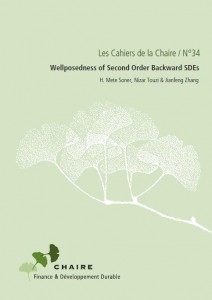 By H. Mete Soner, Nizar Touzi & Jianfeng Zhang (Cahier de la Chaire n°34)
By H. Mete Soner, Nizar Touzi & Jianfeng Zhang (Cahier de la Chaire n°34)
We provide an existence and uniqueness theory for an extension of backward SDEs to the second order. While standard Backward SDEs are naturally connected to semilinear PDEs, our second order extension is connected to fully nonlinear PDEs, as suggested in Cheridito et al. (2007). In particular, we provide a fully nonlinear extension of the Feynman-Kac formula. Unlike Cheridito et al. (2007), the alternative formulation of this paper insists that the equation must hold under a non-dominated family of mutually singular probability measures. The key argument is a stochastic representation, suggested by the optimal control interpretation, and analyzed in the accompanying paper (Soner et al. 2009).
Keywords: Backward SDEs, non-dominated family of mutually singular measures, viscosity solutions for second order PDEs

